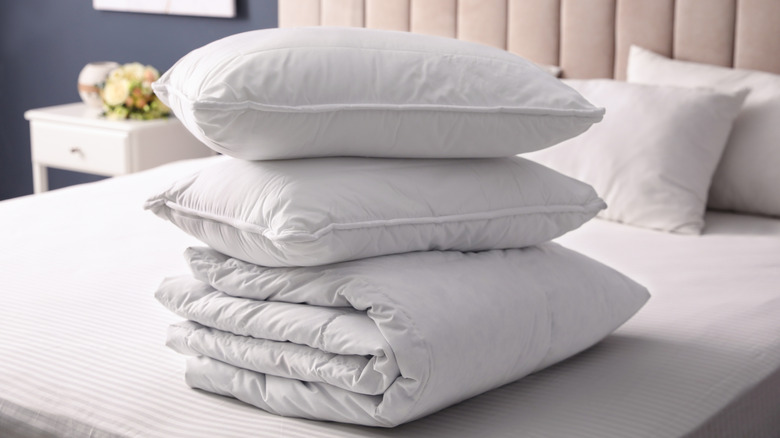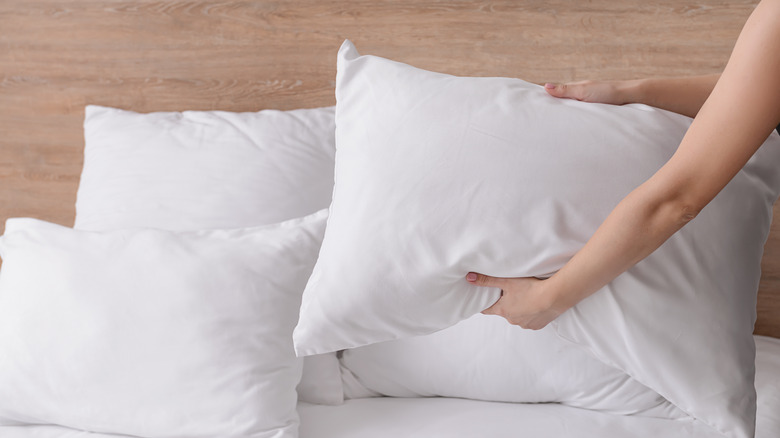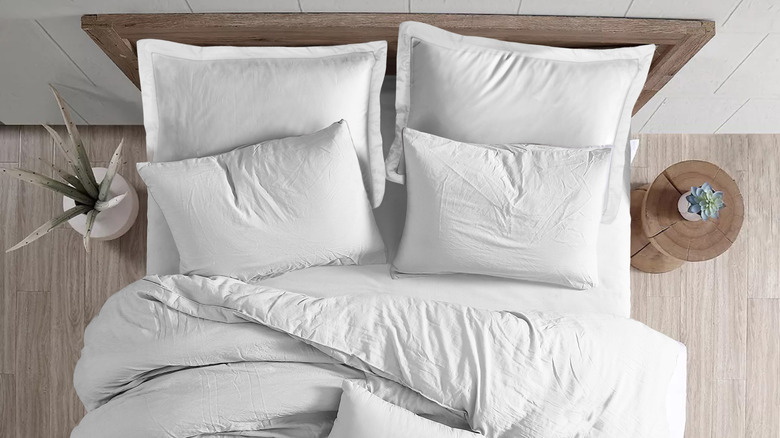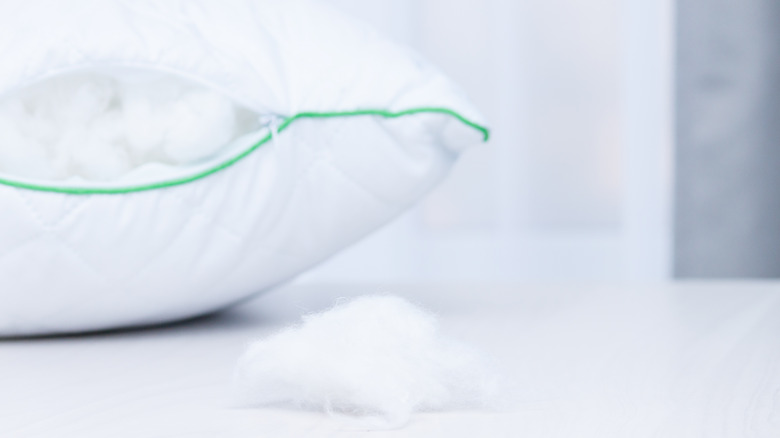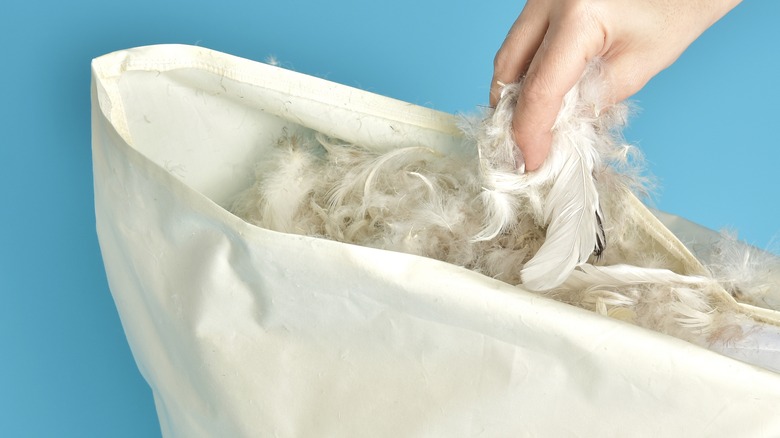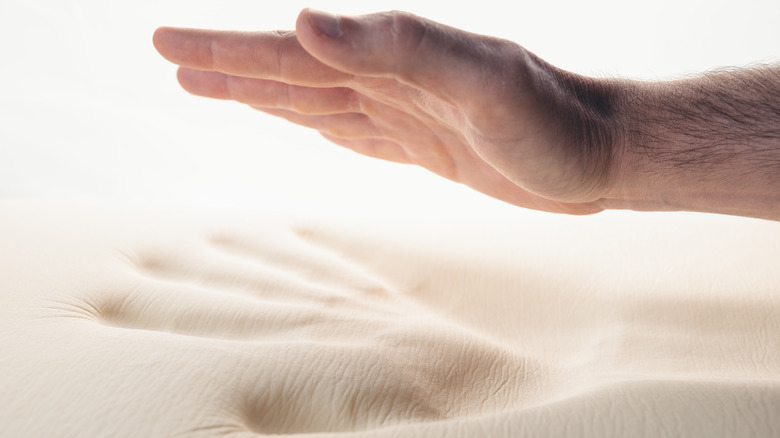The Proper Method For Washing Your Bed Pillows
When cleaning our beds, we often forget about the pillows. While we may dutifully take care of the bedding each week, we tend to forget about the pillows inside those freshly washed pillowcases. Chances are, it's been a while since you've thought of cleaning your bed's pillows. If this is the case, you may want to clean them soon.
According to Healthline, cleaning your bed pillows is extremely important. As the outlet notes, a good night's rest means about eight hours of sleep a day, which means your head is resting on your pillow for several hours daily. Over time, your bed pillows will collect substances, from dust to bacteria to oils.
If you struggle with allergies or sensitive skin, you know how important it is to keep your environment as clean as possible, and this should extend to your bed pillows. As Amy Zack, MD, told the Cleveland Clinic, "Pillows and upholstery can carry germs of all types."
Before cleaning your pillows, you'll first need to know how often they need to be cleaned and if it's actually time to replace them. If it's time to clean them, the material it's made of will dictate the method of washing. Also, make sure to check your pillow's label for further instructions on how to clean it.
When to clean or replace your pillows
Per Best Life, most people should clean their pillows twice a year. However, if a spill or another accident happens on your pillow, you'll need to clean it immediately. And, if you suffer from allergies or sensitive skin, or if you sweat while you sleep, you may need to clean your pillows more often — about once every three months, according to Natalie Barret, a cleaning supervisor and expert, who spoke with the magazine.
However, sometimes cleaning isn't enough and you just need to replace your pillows. You should completely replace your bed pillows once every one to two years. There are also some indicators to tell you if your pillow needs to be replaced. If your pillow is misshapen or extra flat, for example, it's probably a good time to get a new one. Another indicator includes permanent stains or odors on your pillow.
You could also try the folding test, as explained by the Sleep Foundation. To do so, fold your pillow in half, and if it doesn't bounce back, it's time to purchase a new pillow.
How to clean cotton pillows
If you have cotton pillows, you're in luck. Pillows stuffed with cotton are fairly easy to clean. They can be cleaned in the washing machine and dried in the dryer. My Organic Sleep says to begin by removing any pillowcases or covers and cleaning these separately. When placing the pillows in the washer, make sure they have enough room for water to flow around them. A maximum of two pillows should fit in your washer. Then, add a small amount of mild detergent and fabric softener, if desired, and clean with cold water. You'll also want your pillows to go through two rinse cycles to completely clean them and remove excess water.
You can then put your pillows in the dryer on a low heat setting. However, before turning on the dryer, place two tennis balls in socks inside as well. According to HuffPost, this will help your cotton pillows dry faster while also keeping them nice and fluffy.
How to clean polyester pillows
Polyester bed pillows can also be placed in the washer on a delicate and cold water setting with mild detergent. Per Memory Foam Talk, you'll first want to first check for any tears in the seams where the filling could come out in the wash. If possible, repair these with a needle and thread — if not, it may be best to wash them by hand. In fact, washing by hand may be the best way to clean polyester pillows, because they are quite delicate.
To clean them by hand, fill a bathtub with cold water and a small amount of mild detergent, then submerge the pillow and press down gently. Do not twist the pillow, as this could damage it. Drain the tub and fill it with clean water and repeat the process until the water that drips out of the pillow is clear.
To dry, these pillows can also be placed in the dryer with wool dryer balls or tennis balls in socks. However, Memory Foam Talk recommends pausing the dryer at 15- to 20-minute intervals to fluff the pillows. While Amerisleep doesn't suggest this, it does note that the pillows should be dried on low heat and that polyester pillows dry the fastest of all bed pillows.
You could also place your pillows on a flat surface with a towel underneath to air dry. To freshen your pillows, you could sprinkle on baking soda and vacuum after leaving it on for a few hours.
How to clean down or feather pillows
According to Peacock Alley, down or feather pillows can also be placed in the washing machine and dryer as well. In fact, they may get even fluffier and softer after a wash in the washer and a tumble in the dryer. Before cleaning these pillows, however, remove any covers or pillowcases and clean them separately.
Just like with polyester pillows, you'll also want to inspect for any tears in the seams and repair them, if possible. To make sure the washing machine is balanced, you'll want to clean two pillows at the same time. Also, use a mild and low-sudsing detergent and clean on a gentle setting with cool water. An extra rinse and spin cycle will also help remove any excess soap. Amerisleep says the best type of washing machine for down or feather pillows is one without an agitator, given the delicate composition of such pillows. If your drum has an agitator, try placing them into the machine vertically to reduce the twisting action.
After removing the pillows from the washing machine, Peacock Alley says to press each pillow between two towels to remove any excess water. However, refrain from twisting or wringing the pillow. To dry in the dryer, use a low heat setting, pause the dryer to fluff them often, and include dryer balls, to keep the pillows fluffy. After removing the pillows from the dryer, hold each pillow by a corner and shake to reshape it.
How to clean foam pillows
Foam pillows are the hardest to clean because they cannot be placed in the washing machine or dryer. This is because they could be ripped apart. Instead, they must be hand cleaned.
According to BedPillows.com to clean foam bed pillows of a spill from liquids that don't stain, begin by soaking up excess moisture with a dry towel. Then mix a mild detergent with water and spot clean with a sponge in circular motions. For a substance that could stain, you'll need to do a deeper clean. Apply 3% hydrogen peroxide to the stain, then blot with a towel until it stops bubbling. You can then spray it with cold water and scrub gently with an old toothbrush.
For pet stains, there are various formulas you can try — all seem to include hydrogen peroxide and baking soda. Some also call for vinegar. OptimumSleep, for instance, says to try a mix of 1 cup of hydrogen peroxide with 3 tablespoons of baking soda and a bit of liquid dish detergent. Apply this mixture to the affected area overnight, then blot with cold water on a towel.
For a deep clean, BedPillows.com suggests submerging your foam pillow in a tub filled with cool water and mild detergent, then squeezing the pillow but not twisting it. Empty the tub and submerge in clean water until the water is clear. To dry a foam pillow, either allow it to air dry or speed up the process with a hair dryer.
